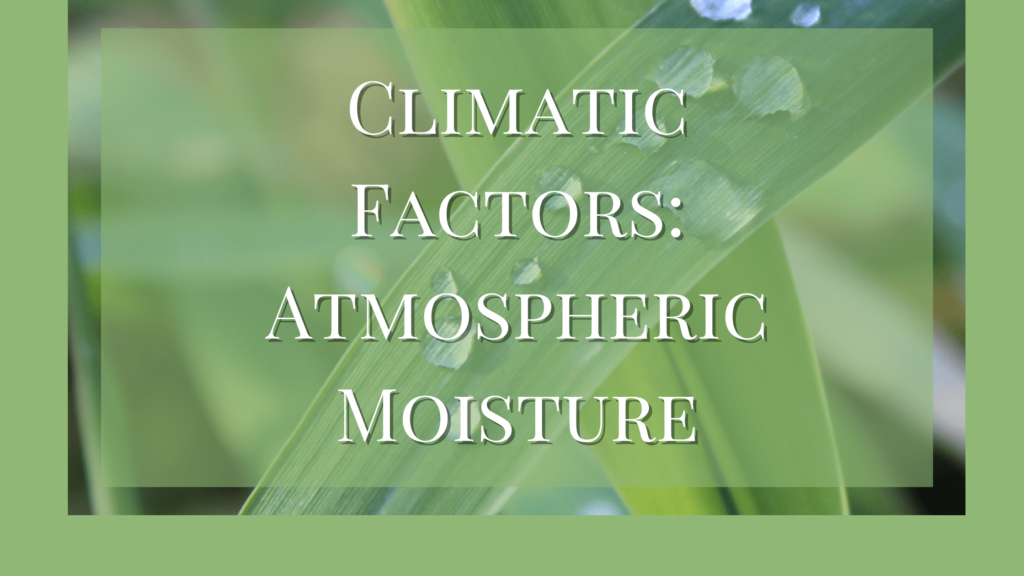Climatic factors in ecology include rainfall, atmospheric humidity, wind, temperature, light, solar energy, etc. Different combinations of these factors cause different climates which are concerned with the production of different types of vegetation, all over the earth.
Atmospheric Moisture or Humidity
Water present in the atmosphere is always in the form of invisible water vapor. This is normally known as the humidity of the air. It helps regulate the temperature in the atmosphere and also absorbs excess heat radiation from the sun.
The quantity of water vapor pressure in the atmosphere at a particular place depends on several factors.
When the atmosphere contains the maximum possible amount of water vapor, it is saturated at a particular temperature and pressure. Any increase in temperature and water vapor remaining constant makes air unsaturated.
The water vapor pressure in a unit volume of air is called absolute humidity. The amount of water vapor required to saturate the same unit volume of air under constant physical conditions is called relative humidity.
At the saturation point, if the temperature is lowered, the water-holding capacity of the atmosphere is reduced, which causes the condition of water vapor in the form of raindrops, frost, snow, mist, etc. This is called precipitation and it is of different types.
- Dew is the condensation of moisture over the surface of the earth, especially plants, during the night.
- Hail is a special type of precipitation that occurs in the form of a ball of ice which is called lumps.
- Snow is solidified precipitation that falls on the ground in the form of branched hexagonal crystals.
Reduction in atmospheric moisture could lead to stunted growth of plants, especially the crops due to soil water deficit.
Mist and Fog as Climatic factors
These are formed due to the cooling of air below the dew point so that water vapor gets transformed into minute water globules. Mist is a cloud-like aggregation of these minute water globules suspended in the air at or near the ground level. Fog is a darkened cloud-like mass of water droplets or ice crystals present over the particles suspended in the atmosphere.
The atmospheric humidity influences the form and structure of plants. It directly affects the transpiration rate of the plants. In a dry atmosphere or when the temperature increases, the rate of transpiration also increases.
Ecological groups of plants
Water requirements of different plant species differ considerably. Based on their water requirements, the plants are grouped into three ecological groups.
- Hydrophytes are adapted to the aquatic environment
- Xerophytes are adapted to grow in dry lands where water content is low.
- Mesophytes live in habitats that usually show neither excess water nor a deficiency of water.
The actual effects on plants may be complicated and include the influence of other climatic factors such as temperature, atmospheric conditions, humidity, etc. The combination of temperature and precipitation plays a vital role in determining plant distribution on the earth’s surface.
Water Cycle (Hydrologic Cycle)
The interchange of water between the atmosphere, land, and sea and between living organisms and their environment is accomplished through the water cycle. The water cycle or hydrologic cycle involves evaporation, transpiration, cloud formation, and precipitation.
Water from the atmosphere reaches the earth’s surface through precipitation and from there, it reaches the atmosphere through evaporation and transpiration.
The amount of water available by evaporation is determined by the amount of water supplied by precipitation and condensation between rainfall input and evaporation output. Therein lies a precarious water balance.
References
- Shukla, R.S. and Chandel, P.S. (2001) Plant Ecology. S. Chand and Company Ltd., New Delhi.
- Verma, P.S., Agarwal, V.K. (1999). Cell Biology Genetics Molecular Biology Evolution and Ecology. New Delhi: S.Chand Co.(Pvt) Ltd.




